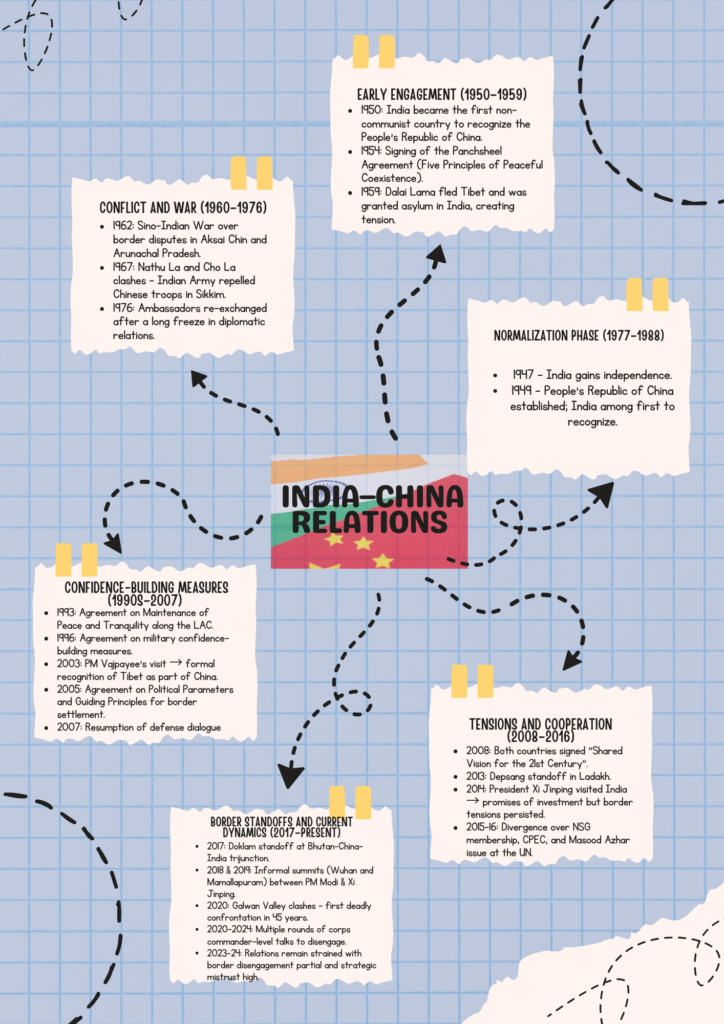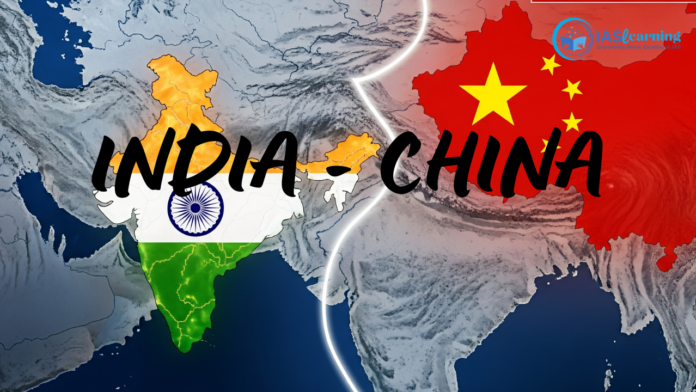India–China Relations
India–China Relations share a long history of cultural, economic, and political ties. However, their relationship has been marked by moments of cooperation, mistrust, border disputes, and competition for regional dominance. Below is a timeline highlighting the key phases of India–China relations:

Ancient Civilizations to Pre-Independence: Bonds of Culture and Philosophy
The roots of India-China relations go back centuries, long before the modern nation-states emerged.
- Buddhism as a bridge: Indian monks like Faxian and Xuanzang traveled between the two civilizations, spreading knowledge and philosophy. Nalanda University hosted Chinese scholars, strengthening cultural ties.
- Trade through the Silk Route: Indian spices, textiles, and knowledge of medicine flowed to China, while China exported silk and ceramics.
- Despite geographical barriers like the Himalayas, civilizational exchanges were rich, peaceful, and deeply philosophical.
1947–1962: From Brotherhood to Betrayal and Border War
After India’s independence (1947) and the founding of the People’s Republic of China (1949), both countries initially celebrated their shared anti-colonial struggles.
- “Hindi Chini Bhai Bhai”: The slogan symbolized friendship as both nations signed the Panchsheel Agreement (1954) promoting peaceful coexistence.
- Tibet Factor: Relations soured when China took control of Tibet in 1950. India’s asylum to the Dalai Lama in 1959 angered Beijing, triggering mistrust.
- 1962 Sino-Indian War: The most negative turning point came when border disputes over Aksai Chin (Ladakh) and NEFA (now Arunachal Pradesh) escalated into a war. India suffered a humiliating defeat, leaving a long shadow of mistrust.
1962–1990: Cold War Rivalry, Hostility, and Diplomatic Freeze
The decades following the war witnessed strained diplomatic and political ties.
- Border Hostility: Sporadic skirmishes occurred as both sides fortified their positions along the Line of Actual Control (LAC).
- Geopolitical Alignments: India leaned towards the Soviet Union, while China aligned with Pakistan and the United States, fueling strategic hostility.
- Trade and Dialogue Stagnation: Bilateral trade was negligible, and high-level political contacts were frozen.
By the 1980s, both countries realized that their rivalry hindered economic growth and regional stability, leading to gradual efforts at rapprochement.
1990–2008: Normalization, Trade Boom, and Strategic Engagement
The end of the Cold War created space for renewed engagement between India and China.
- Rajiv Gandhi’s 1988 Visit: Marked the beginning of normalization. Both nations set up Joint Working Groups on border issues.
- 1993 & 1996 Agreements: Confidence-building measures reduced the immediate risk of conflict along the LAC.
- Economic Engagement: Trade grew exponentially—from just $2 billion in the 1990s to $50 billion by 2008. China emerged as India’s largest trading partner.
- BRICS and SCO Cooperation: India and China cooperated in multilateral forums, showing signs of pragmatic engagement.
2008–2020: Strategic Competition, Border Tensions, and Diplomatic Showdowns
The new millennium saw greater competition and conflict overshadowing cooperation.
- 2008–2013: India raised concerns about China’s Belt and Road Initiative (BRI) and its encirclement strategy (“String of Pearls”). Border standoffs at Depsang (2013) and Chumar (2014) increased tensions.
- Doklam Standoff (2017): A 73-day military standoff in Bhutan’s Doklam plateau highlighted the volatility of the border dispute.
- Wuhan Spirit (2018): PM Modi and President Xi Jinping attempted to reset ties through informal summits at Wuhan and later in Mamallapuram (2019).
- Galwan Valley Clash (2020): The deadliest border conflict in over 40 years resulted in casualties on both sides, shattering trust and sparking anti-China sentiment in India.
2020–2025: Stalemate, Strategic Rivalry, and the Road Ahead
In the post-Galwan era, India-China relations remain tense and uncertain.
- Military Standoff: Both sides have deployed thousands of troops along the LAC, with disengagement talks producing limited progress.
- Economic Decoupling: India banned Chinese apps, restricted investments, and strengthened supply chains, though China remains a key trading partner.
- Global Geopolitics: India’s closer ties with the US and participation in the QUAD are seen as countering China’s influence in the Indo-Pacific.
- Ongoing Diplomatic Efforts: While talks continue, mistrust persists, and border peace remains fragile.
The future trajectory will depend on whether the two nations can resolve territorial disputes, balance economic interests, and avoid dangerous escalation.
The history of India-China relations is one of contrasting narratives—civilizational friendship vs. modern-day rivalry, economic interdependence vs. geopolitical competition, and dialogue vs. distrust.
As of 2025, the relationship stands at a critical crossroad. Both nations, home to nearly 40% of humanity, have the potential to cooperate for global stability, yet their unresolved border conflict and strategic mistrust continue to cast a dark shadow.
Whether India and China choose peaceful coexistence or sustained hostility will not only define Asia’s future but also shape the balance of power in the 21st century.
FAQs on India-China Relations
Q1. What is the history of India-China relations?
India-China relations have a long history marked by cultural exchange, trade, and spiritual ties. However, modern relations have been shaped by the 1962 India-China War, border disputes, and changing geopolitical dynamics. Despite conflicts and mistrust, the two Asian powers have engaged in diplomacy, trade, and security dialogues to maintain stability.
Q2. Why is the India-China border dispute significant?
The India-China border dispute is significant because it affects national security, regional stability, and global geopolitics. Disputed regions like Aksai Chin (controlled by China but claimed by India) and Arunachal Pradesh (claimed by China but part of India) remain contentious. Skirmishes like the Galwan Valley clash (2020) highlighted the fragile peace and negative impact on bilateral trust.
Q3. How did the 1962 India-China War impact relations?
The 1962 war was a turning point that created deep mistrust. India’s defeat highlighted military weaknesses and strained ties for decades. The war also led to militarization of the border and long-term hostility. Even today, the memory of this war influences Indian public opinion and strategic policies toward China.
Q4. What was the impact of the Galwan Valley clash in 2020?
The Galwan Valley clash (June 2020) was the deadliest India-China confrontation in 45 years, resulting in soldiers’ deaths on both sides. It caused a negative shift in public perception, damaged trust, and triggered India’s boycott of Chinese apps and investments. It also led to increased military presence along the LAC (Line of Actual Control).
Q5. How important is trade in India-China relations?
Despite political tensions, India-China trade has grown significantly. China is India’s largest trading partner, with bilateral trade crossing $136 billion in 2022-23. However, India faces a huge trade deficit with China, which is a growing concern for economic security. This dependency creates a paradox where cooperation and rivalry coexist.
Q6. Why is the Line of Actual Control (LAC) disputed?
The LAC (Line of Actual Control) is disputed because India and China have different perceptions of the border. This leads to frequent incursions, standoffs, and skirmishes, especially in Ladakh, Arunachal Pradesh, and Sikkim. The lack of a clear demarcation fuels tensions and negative confrontations.
Q7. What role does China’s support to Pakistan play in India-China tensions?
China’s strategic partnership with Pakistan, including the China-Pakistan Economic Corridor (CPEC) and military support, adds to India’s security concerns. This trilateral equation creates mistrust and amplifies India’s perception of a negative Chinese threat in South Asia.
Q8. Can India and China resolve their disputes peacefully?
Yes, but it requires mutual trust, diplomatic negotiations, and compromise. Over the years, both sides have signed agreements to maintain peace, like the 1993 and 1996 border agreements. However, recurring violations, military build-up, and China’s aggressive policies make resolution difficult. Peace is possible but requires political will and respect for sovereignty.
Also Read: Truth Knows No Colour: UPSC Essay 2025




